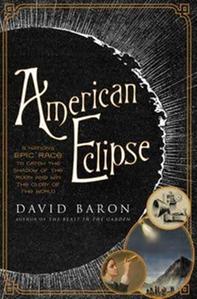
 When science journalist David Baron (The Beast in the Garden) viewed a total solar eclipse for the first time, he was surprised by his passionate response. "For three glorious minutes... my consciousness departed the earth and I gaped at an alien sky.... It looked like an enormous wreath woven from silvery thread, and it hung suspended in the immensity of space, shimmering." That experience made him a devoted eclipse chaser, and eventually led him to the story of the eclipse that was visible from the United States' Wild West in 1878.
When science journalist David Baron (The Beast in the Garden) viewed a total solar eclipse for the first time, he was surprised by his passionate response. "For three glorious minutes... my consciousness departed the earth and I gaped at an alien sky.... It looked like an enormous wreath woven from silvery thread, and it hung suspended in the immensity of space, shimmering." That experience made him a devoted eclipse chaser, and eventually led him to the story of the eclipse that was visible from the United States' Wild West in 1878.
In the late 19th century, eclipses were not only a rare spectacle, but an exceptional opportunity for American astronomers, too. They could study the bodies of the solar system and the chemical composition of the sun, and prove themselves the scientific equals of their European counterparts. Congress reluctantly funded an expedition, and independent teams as well as mobs of tourists swarmed west for the great 175-second (or less) event. Baron builds his story around three vivid figures: young Thomas Edison, who assembled a "tasimeter" to measure the heat of the stars; Maria Mitchell, an adored astronomy professor at Vassar College who headed an all-woman team; and James Craig Watson, a competitive, unscrupulous astronomer who had discovered a record number of asteroids. All three of them probably benefited most from the positive publicity of their expeditions. Edison was a celebrity inventor on the rise who traveled in an opulent Pullman "hotel car," an "unflagging salesman who... effortlessly embellished reality, exaggerating the progress of his work and downplaying obstacles." Mitchell "saw it as her role not only to teach female students but to foster a sense of community, to create the kind of supportive environment for intelligent women so lacking in the outside world." Watson went away convinced that he had discovered the planet Vulcan and was lionized by the newspapers, for a while.
Baron mingles the excitement, aspiration and drama of these events with a good dose of technical information and scientific history. Archival photos, sketches and prints are scattered throughout the pages. This is a wonderful, dramatic piece of scientific history, and a fine companion for eclipses to come. --Sara Catterall
Shelf Talker: This dramatic episode in U.S. scientific history is told through the stories of three scientists who traveled West to view the total solar eclipse of 1878.

